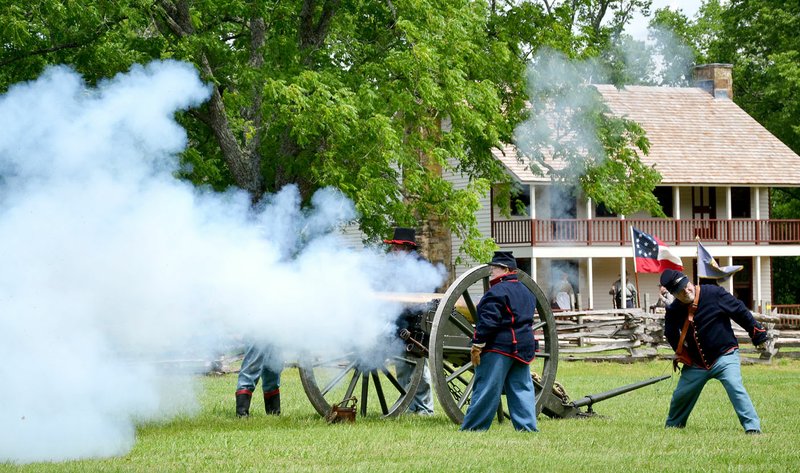Standing resolute and silent, the iconic Elkhorn Tavern is a testimony to the resilience of man, the perseverance of the human spirit and bridges the gap between the Ozarks of the 1830s and today's digital world. Though damaged, repaired, added onto to and demolished, the tavern today stands as it appeared in the 1880s providing a tangible testimony to the many lives that crossed the path of that establishment in the Arkansas Ozarks. It was reopened Saturday, June 15, in a ceremony marking its long, varied history.
"We live in an immediate world, a digital world -- one full of photographs, video and voice feeds. Because of that, as the superintendent, I struggle at times to make relevant the importance of preserving this park -- the battlefield, brick, stone and mortar -- this tavern," Kevin Eads, Pea Ridge National Military Park superintendent, said. "This battlefield is sacred. The ground we stand on is hallowed... it's consecrated.
"Many a tear and much more in blood has been shed on this very spot so that we today can stand in honor, not only of the Civil War soldiers that fought and died here, but all Americans who took up that mantle and sacrificed for us, for you, for me. When I think about it in that way, I'm humbled, deeply honored and I find it hard to express the amount of gratitude I have for all soldiers, past and present.
"This tavern is iconic.
"It's iconic to me because it serves as a benchmark -- something that can be seen and touched. It serves as an anchor point for the landscape of this park. It transcends time. Because of this, it helps bridge that gap between the digital and physical world and it does make relevant the importance of preserving it and this battlefield," Eads said.
The original Elkhorn Tavern was built about 1833 by William Reddick and his son-in-law, Samuel Burks, according to Eads, originally as a single-family dwelling. Served as a trading post, post office and place of worship during the 1840s and 1850s.
In 1858 (four years before the Battle of Pea Ridge), Burks sold the house and 313 acres to Jesse and Polly Cox for $3,600. Cox made improvements including adding siding and an outside staircase as well as adding the set of elk horns on the roof line which gave the tavern its name.
Prior to the Civil War, Eads said the house was used for many purposes and was a stop for the Overland Stage which traversed the Telegraph Road.
In February and March 1862, the fields surrounding the tavern were used for the Federal army's main supply camp, Eads explained and during the battle in March, the tavern was used as a field hospital. The residents, Polly Cox, her son Joseph and his wife Lucinda and the two youngest children, Elias and Franklin, stayed in the cellar, Eads said. The tavern, although hit by a cannonball, survived the battle intact, Eads said.
It was later burned in January 1863 by Confederate bushwhackers and later rebuilt by Joseph Cox soon after the end of the war. It was transferred to the National Park Service on March 7, 1960.
The first battle reunion was held there in 1880, Eads said. In the 1880s a second story was added to the tavern. In 1903, a one-story addition of two rooms was added to rear. In 1917, building was extended to the north by 6 feet.
In 1926, a reunion was held here. Also, an Act of Congress established the Battlefield Commission with one Union and one Confederate veteran to survey the landscape, the battlefield.
In 1940, it served as a museum.
In 1959, the property was purchased by the State of Arkansas.
"It had remained in the Cox family for over 100 years," Eads said, adding that the tavern was transferred to the National Park Service on March 7, 1960. Between 1964-1969, the building was partially demolished, later additions were removed, and it was rebuilt to match the 1880s building as seen in historic photographs.
Eads commended his staff for their hard work in preserving the battlefield and the tavern and especially Troy Banzhaf, chief of interpretation, historian who "knows more than anybody I've ever met about the battle."
"I went through the time frame ... to give you an idea of this structure, the importance of this structure, the road you're standing on, this site and the battlefield.
"It demonstrates that not only does the tavern transcend time, but time marches on," he said.
Eads said it's his responsibility to look at the "big picture" and realizes every decision has the potential for long-term consequences. He said the decisions to preserve the tavern was an easy one because the structure is "iconic, iconic in nature ...
"Because of that it serves as a touchstone for this consecrated site, the hallowed battlefield, those who came before the battle, those who came during and after and the many visitors who will continue to travel this way," Eads concluded.
Community on 06/19/2019

